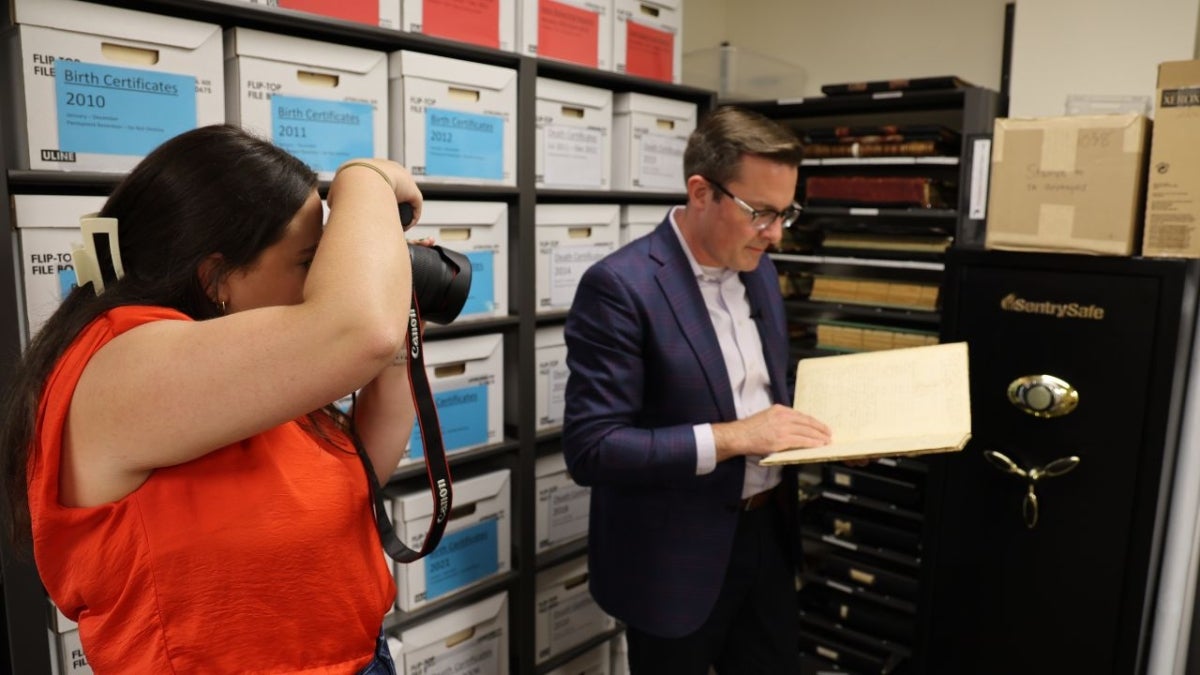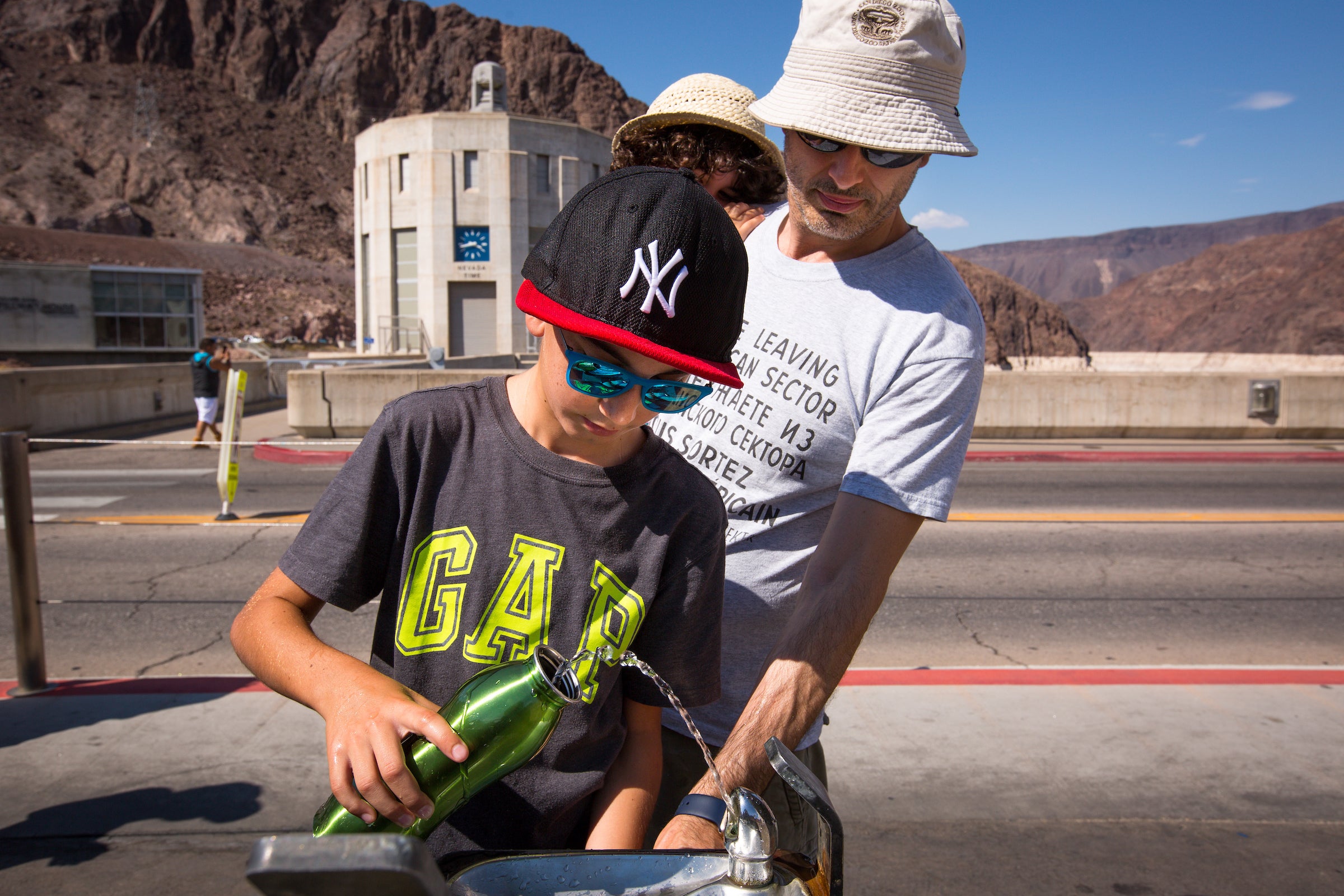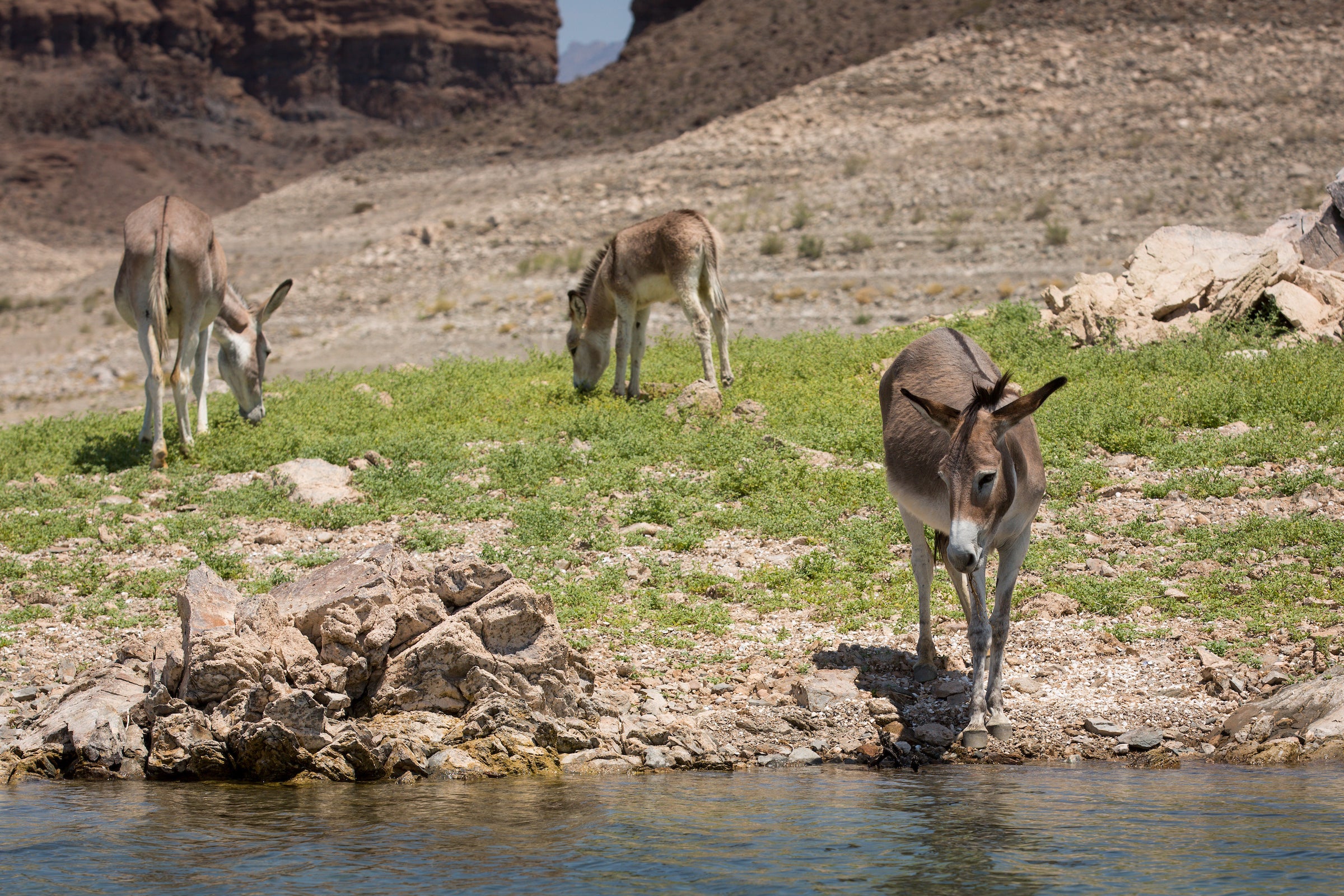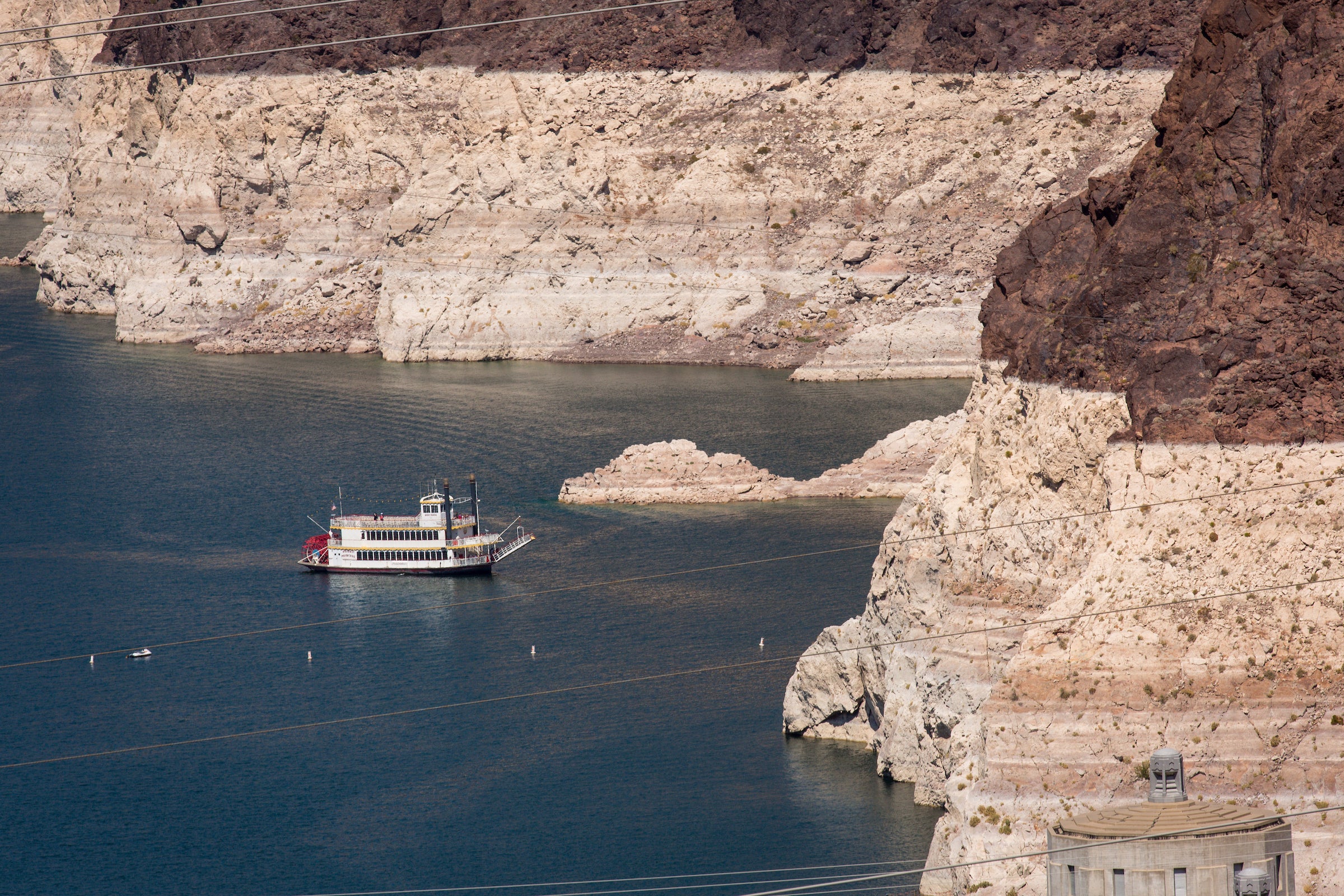Editor's note: This story is being highlighted in ASU Now's year in review. To read more top stories from 2016, click here.
This is the first of a three-part series examining the work that ASU is doing in the realm of water as a resource in the arid West. We’ll explore solutions, but first we look at the current situation and how we got here.
HOOVER DAM — Atop Hoover Dam on a 115-degree July afternoon, tourists line up to suck cold water from fountains and crowd into the air-conditioned cafe and visitors’ center.
Transpose both those actions to the 30 million people who depend upon that blue-green water behind the dam. That’s water for a jogger in Santa Monica. Water for an oleander hedge in Phoenix. Water for a shower to wash away a night in Vegas. It’s a comforting sight on a scorching day, all that water.
What’s disconcerting is the white bathtub ring about 200 feet above the surface.
Talk to the experts, and they’ll all tell you the same thing: That ring is never going away again. Between climate change and an ongoing drought, the ring is a stark reminder of another iteration of that hated 21st-century term: the “new normal.”
“I think people have come to the recognition that the infrastructure which has served us so well over the last 100 years is not going to do the same job in the next 100 years,” ASU research professor Pat Gober said.
That bathtub ring has been growing for years. There’s a number every water professional in the Colorado River Basin knows: 1,075.
When the water in Lake Mead behind Hoover Dam drops below 1,075 feet, it will automatically trigger a round of mandatory water-use cuts to each state. Agriculture will take the first hit. Subsequent cuts tied to lake levels become more draconian. The ring is a visible symbol of how precariously Westerners live.
And we do live precariously. Anyone whose air-conditioning has broken during a Phoenix summer or whose car battery has died on the freeway can tell you, it gets unbearable in a hurry. The ancient Hohokam people took off from what is now south-central Arizona during an epic drought in the Medieval Ages.
But 30 million people aren’t going to just pick up and leave. If this is the “new normal,” we’re going to have to figure out a way to survive here.
There’s no magic bullet. It’s going to take a range of strategies from experts in law, policy, science, and technology. Some of those strategies are already in place. Some won’t exist for another 10 or 20 years.
That’s what this story is about. It’s about how a wide range of scientists at Arizona State University are putting their broad and diverse expertise toward solving the problem of how people in the arid West will continue to live sustainably, in a place where people basically have no business living at all.
Hoover Dam draws tourists from around the world. Here, a family from Italy fills a water bottle in the 115-degree heat July 27, with Lake Mead's "bathtub ring" visible behind them. Photo by Charlie Leight/ASU Now
“We’re realizing that water as a resource is in many realms, and an institution of this breadth is what’s needed to address these problems and provide solutions and study the phenomenon from multiple angles,” said hydrologist Enrique VivoniVivoni is an associate professor, School of Earth and Space Exploration, College of Liberal Arts and Sciences; sustainability scientist, Julie Ann Wrigley Global Institute of Sustainability; affiliated faculty, Center for Biodiversity Outcomes, Julie Ann Wrigley Global Institute of Sustainability..
This story is about nuance. Conserve! (But keep your lawn and pool.) Worry about levels in Lake Mead! (But don’t worry about every fluctuation or weather event.) Water people know they’re sending mixed messages. They’re mixed on purpose. They have to be.
“Everything about water is complicated,” said Sarah Porter, director of the Kyl Center for Water Policy at ASU. “I love that about water.”
Where to begin?
“It's such a big issue,” said Karen Smith. “It's so fundamental.”
Smith, a faculty associate in the School of Sustainability, teaches a course on water use. She’s a veteran water warrior: strategic planner for the Salt River Project, the quasi-governmental agency charged with administering the flows from the Salt and Verde Rivers, one of Phoenix’s main water sources; water-quality director at the state Department of Environmental Quality; deputy director of the state Department of Water Resources.
“One of the real problems I think we have when we start to talk about it is where to start,” she said. “Where do you start? Do you start with the science? Do you start with the policy, with sort of the politics to go with the economics of it? It's crazy. There's so much to it, and part of the challenge we've had in Arizona is knowing where to begin.”
What’s going on
“We’re all watching the lake levels in Mead,” said Pat Gober. “That’s the visual emblem of water infrastructure that’s worked for us in the past.”
Gober, a research professor in ASU’s School of Geographical Sciences and Urban PlanningThe School of Geographical Sciences and Urban Planning is an academic unit in the College of Liberal Arts and Sciences., has won international prizes for her water research. She studies water resources management, decision making under uncertainty and urban climate adaptation.
“We’re going to fall below (the 1,075 line) soon, and then we’re going to have to figure out a new plan for the future, because the amount of Colorado River water we assumed we were going to get, we’re not going to get,” she said. “It’s a brave new world for us, I think, and that’s the symbol of it.”
Water and climate people talk about a “new normal” because they don’t believe that those lake levels will return to what they were 50 years ago.
“That means we have to change the economy and the culture,” Gober said. “It’s going to be some kind of radical change.”
While changing the economics of water is a relatively simple proposition (more on that later), changing culture is another story.
Across the West, each city dependent on the Colorado River has its own unique challenges, but overarching all is the urgent need for survival in a dry place, whether that’s Denver, Las Vegas, San Diego or Phoenix.
The Arizona capital is a river city.
“We’ve taken the water out of the river and spread it across the landscape,” said ASU professor Nancy GrimmGrimm is a professor in the School of Life Sciences, in the College of Liberal Arts and Sciences; Senior Sustainability Scientist in the Julie Ann Wrigley Global Institute of Sustainability; director, Central Arizona–Phoenix Long-term Ecological Research Project, Julie Ann Wrigley Global Institute of Sustainability; co-director, Urban Resilience to Extremes Sustainability Research Network, Julie Ann Wrigley Global Institute of Sustainability; and affiliated faculty, Center for Biodiversity Outcomes, Julie Ann Wrigley Global Institute of Sustainability., who studies desert streams and how water works in urban ecosystems.
“We call it riparianization of the city, because you’ve turned this what was a single riparian strip along the river into this big blob that’s all green, and when you fly into Phoenix you see that,” she said. “A lot of what we see in terms of the ecology of the city, the kinds of things that we’ve been studying in people’s yards, the vegetation that’s here, the kinds of birds that you see, the soil properties, all of these kinds of things are related to that fact. And if you think about it in historical terms, that water was spread across the landscape initially to create farmlands. Farmland has converted to housing.”
At the turn of the previous century, Arizona had a desolate national reputation because of the desert and violence. It was the wild West, after all. Early boosters of Phoenix created marketing materials around 1910 exhorting people to move to Arizona. Promotional pamphlets usually depicted orange groves and canals. Almost never was a cactus shown. (The same applies to ASU during the same time, where campus was touted as a lush oasis with a huge fountain in front of Old Main.)
“We made the urban environment attractive to people who were coming here,” Gober said. “We created an oasis culture, not a desert culture. This isn’t a desert city. It uses water from all across the West, dammed up in those big dams to make our city look like Chicago and Philadelphia and northern California. Maybe it was a good thing to do 100 years ago, but it’s not going to work for us.”
The ability of the region to grow is a function of the ability to capture and use large amounts of water. The future of arid cities is dependent on our use of water. Gober points out we use water to make the place make sense for us.
To a certain extent, that will have to change out of necessity.
“We’ve totally transformed this landscape, but the work that (ASU) has done looking at the future in terms of climate change, in terms of population is suggesting that we can’t keep doing that,” Grimm said.
A group of wild burros consume a little vegetation and water next to Lake Mead on July 28. The Colorado River, which feeds Lake Mead, is crucial to life of all kinds in the West. Photo by Charlie Leight/ASU Now
The only way to support the current population is by storing water in years of plenty to use in times of shortage. The way we’ve been doing that is by using a massive infrastructure of canals, dams and lakes. The heroic engineering marvels of the 20th century, like Hoover and Glen Canyon dams and the Central Arizona Project canal, gave Westerners stability and the ability to change the landscape.
But now the rains aren’t showing up. Far more people live in the West now than did in the 1930s, when Hoover was built. And the wild cards of drought and climate change hover over it all.
All of the allocations of Colorado River water that Arizona thought it was going to get have to be rethought. State water managers don’t use historical data sets to predict rainfall and snowpack because they’re not representative of what’s happening now. Arizona’s Department of Water Resources uses rainfall records going back to 1988 — what the agency director calls a stress test period — plus models that incorporate climate change.
The problem
If you check the Bureau of Reclamation’s website, Lake Mead is often slightly below 1,075 feet. Why isn’t everyone freaking out over this?
The lake fluctuates a lot because of rain, evaporation and a host of other factors, according to Porter, of the Kyl Center for Water Policy.
Mead’s diminishing levels aren’t due to drought: It’s over-allocation, which doesn’t account for loss. About 1.2 million acre-feet are lost every year because of evaporation, seepage into porous surfaces, and so on.
“The lake level will be going down every year no matter what because of this structural deficit, as it’s called,” Porter said.
An acre-foot is the measurement water wonks use. They don’t talk about gallons. An acre-foot is one acre covered by water a foot deep. (It’s about 326,000 gallons, if you must know.) Most water managers call an acre-foot enough water for a suburban family for a year.
According to the Bureau of Reclamation, the lake’s surface drops 12 feet per year. When Hoover was built, no one thought about this.
“At the time there was so much water, and we didn’t have nearly the demands we have now,” Porter said .
A 2011 study of the Colorado River Basin by the Bureau of Reclamation (motto: “Managing Water in the West”) predicted a 3 million acre-foot gap in 2040.
“Too many straws in it,” said John Sabo. Sabo, a professor in ASU’s School of Life Sciences, has loved to fish since he was a boy. He earned a degree in stream ecology, studied hydrology, and eventually ended up studying water, because everything in Arizona revolves around water.
The Bureau of Reclamation makes its determination for the coming year on Oct. 1, the beginning of the water year. (Like finance, the calendar and taxes, there is a water year.)
An August report by the bureau headed off a shortage declaration by predicting lake levels will be 4 feet above the trigger point at the end of the year. (They also predicted a shortage to be declared in 2018.)
“Levels are not declining as quickly,” Porter said. Conservation “efforts are paying off.”
The Desert Princess paddleboat offers tours of Lake Mead near the Hoover Dam on July 27, with the "bathtub ring" a visible reminder of the volume of water missing from the Colorado River-fed reservoir. Photo by Charlie Leight/ASU Now
This wasn’t a huge surprise to anyone in water management. The Colorado River is not a natural system, Smith, from the School of Sustainability, pointed out. No one wants the shortage declaration and the mandatory cuts that will accompany it, so an enormous amount of shuffling happens to prevent that.
“It's a highly plumbed river,” Smith said. “And so they manage it. So they'll look at Mead, and they'll look at Powell and they'll say, ‘You know, let's take a little bit more from Powell now and bring it down to Mead because it looks like they'll be some better inflows into Powell. … So we'll see what the bureau does when it gets close to 1,075.”
It’s an enormous system to manage. There are two countries, upper- and lower-basin states, treaties, regulatory backgrounds, judicial backgrounds and legal precedents. The whole mess is collectively called the Law of the River.
It’s a delicately balanced system. At a recent water meeting at the state Capitol, one panelist described it as a Rubik’s Cube, with each square representing a different stakeholder. Turn the cube once, and the whole system goes out of whack.
Water managers aren’t expecting a rosy future.
“Climate change is already a huge challenge for us,” said Kathryn Sorensen, water services director for the city of Phoenix. “We can expect that the flows of our local rivers, the Salt and Verde, will diminish and become more variable or potentially turbid. We can expect that we will enter into shortage on the Colorado River and probably stay in shortage for quite some time.”
Climate change, drought, or both?
This is Arizona’s 16th year in a drought. Is this year 16 of a 16-year drought, or year 16 of a 30-year drought? NASA’s most recent research suggests the latter might be the case, with an 80 percent chance to see a 30-year drought by the middle to end of this century.
Droughts are part of natural variability in a desert region, but there is research that suggests they are becoming worse and more frequent because of climate change. Weather patterns in the Pacific that affect the West are changing, but researchers don’t know why.
“(Climate change and drought) are working together, unfortunately,” said state climatologist Nancy Selover, a research professor in the School of Geographical Sciences and Urban Planning. “I wish I could say 43 percent is this and 43 percent is that, but I can’t do that. It’s a fairly complex system.”
The water series
Part 1: The current situation and how we got here.
Part 2: Science and research.
Part 3: Law, policy, challenges — and some good news.
Top photo: The Mike O’Callaghan-Pat Tillman Memorial Bridge on U.S. 93, a bypass from the old route over Hoover Dam, provides a scenic view of the dam and Lake Mead. Photo by Charlie Leight/ASU Now
More Law, journalism and politics

Native Vote works to ensure the right to vote for Arizona's Native Americans
The Navajo Nation is in a remote area of northeastern Arizona, far away from the hustle of urban life. The 27,400-acre reservation is home to the Canyon de Chelly National Monument and…

New report documents Latinos’ critical roles in AI
According to a new report that traces the important role Latinos are playing in the growth of artificial intelligence technology across the country, Latinos are early adopters of AI.The 2024 Latino…

ASU's Carnegie-Knight News21 project examines the state of American democracy
In the latest project of Carnegie-Knight News21, a national reporting initiative and fellowship headquartered at Arizona State University’s Walter Cronkite School of Journalism and Mass Communication…



